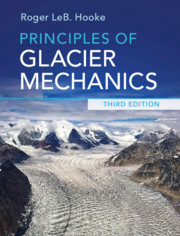Book contents
- Principles of Glacier Mechanics
- Reviews
- Principles of Glacier Mechanics
- Copyright page
- Dedication
- Contents
- Preface to the third edition
- Preface to the second edition
- Preface to the first edition
- Physical constants relevant to ice
- Derived SI units and conversion factors
- 1 Why study glaciers?
- 2 Some basic concepts
- 3 Mass balance
- 4 Flow and fracture of a crystalline material
- 5 The velocity field in a glacier
- 6 Temperature distribution in polar ice sheets
- 7 The coupling between a glacier and its bed
- 8 Water flow in and under glaciers: Geomorphic implications
- 9 Stress and deformation
- 10 Stress and velocity distribution in an idealized glacier
- 11 Numerical modeling
- 12 Applications of stress and deformation principles to classical problems
- 13 Ice streams and ice shelves
- 14 Finite strain and the origin of foliation
- 15 Response of glaciers to climate change
- 16 Ice core studies
- Problems
- References
- Index
8 - Water flow in and under glaciers: Geomorphic implications
Published online by Cambridge University Press: 20 December 2019
- Principles of Glacier Mechanics
- Reviews
- Principles of Glacier Mechanics
- Copyright page
- Dedication
- Contents
- Preface to the third edition
- Preface to the second edition
- Preface to the first edition
- Physical constants relevant to ice
- Derived SI units and conversion factors
- 1 Why study glaciers?
- 2 Some basic concepts
- 3 Mass balance
- 4 Flow and fracture of a crystalline material
- 5 The velocity field in a glacier
- 6 Temperature distribution in polar ice sheets
- 7 The coupling between a glacier and its bed
- 8 Water flow in and under glaciers: Geomorphic implications
- 9 Stress and deformation
- 10 Stress and velocity distribution in an idealized glacier
- 11 Numerical modeling
- 12 Applications of stress and deformation principles to classical problems
- 13 Ice streams and ice shelves
- 14 Finite strain and the origin of foliation
- 15 Response of glaciers to climate change
- 16 Ice core studies
- Problems
- References
- Index
Summary
Water flowing through veins along 3-grain intersections enlarges veins, forming conduits. At depth, the conduits are likely normal to equipotential planes that dip upglacier at ~11-times the slope of the glacier surface.Along the bed, the water flows normal to the intersection of the equipotential planes with the bed. Basal conduits are likely broad and low. Their size reflects a balance between melting by energy dissipated by the flowing water and closure due to pressure in the ice that slightly exceeds that in the water. In a steady state, water pressure in these conduits decreases with increasing discharge, leading to an arborescent drainage network. Water at the bed also moves through a distributed drainage system consisting of cavities linked by small conduits. In this system, water pressure may increase with discharge. Water pressures building up in this system may lead to surges. Conduits on till are more complicated because conduit shape is adjusted to provide a sediment transport rate equal to the rate of sediment supply. Near the glacier margin, sediment deposited in subglacial conduits may form eskers. Tunnel valleys form when subglacial lakes drain catastrophically.
Keywords
- Type
- Chapter
- Information
- Principles of Glacier Mechanics , pp. 199 - 255Publisher: Cambridge University PressPrint publication year: 2019



